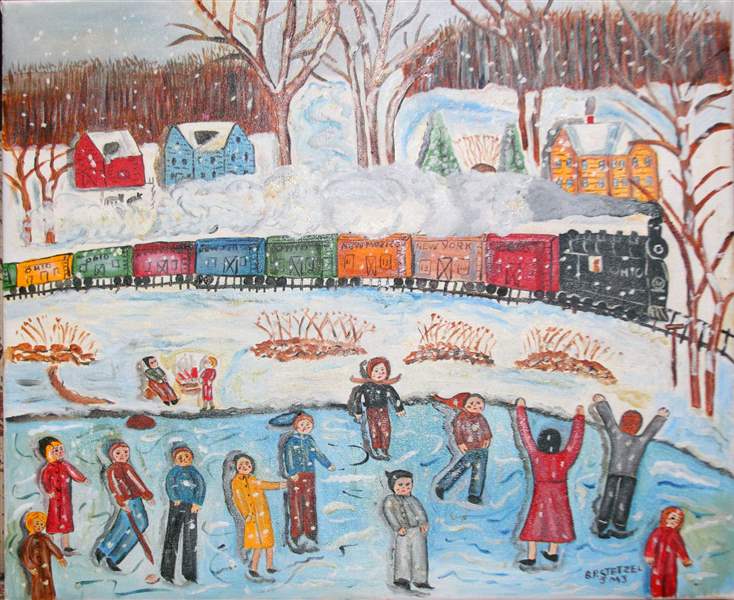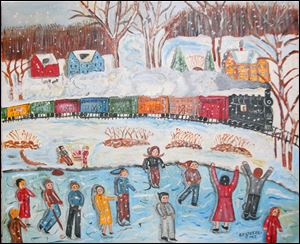
Bernardine Stetzel, 86, creates happy scenes in primitive style
1/12/2014
Using primary colors, Bernadine Stetzel, of Fremont, paints happy scenes that often hark back to small-town America in the 1930s and 1940s. This work is 'Ice Skating on a Pond.'

"In math, two and two always equal four," Bernadine Stetzel, 86, said, "but in artwork two and two can be any number and that sums my artwork up."
In one fell swoop, Bernadine Stetzel sold 350 paintings and got four of her books published.
2013, her 86th year, was a good one indeed.
Stetzel paints every day in the parlor of her Victorian home. She sits or stretches out on an antique couch, and on the back of a canvas, pencils a scene she may have envisioned in the pre-dawn hours when sleep eludes her.
“I visualize it. I used to get up and sketch and bake cookies and pies. Now I lay there and pray and think.”
The subject she brought to a December day was set in the 1800s, of people playing croquet. She squeezes paint onto her palette, a foam plate encircled with plops of primary colors.
“I use all pure colors right out of the tube. I don’t mix them. I tried mixing them and they looked muddy, except for pink and gray,” she said. “I put on two coats. The first is boring. With the second coat I go into more detail and it comes to life.”
Chances are, it was finished the same day and she didn’t second-guess it.
“I’m not a second-thought person.”
She recently did a winter scene of children tobogganing and another of a covered bridge over the Sandusky River in Tiffin that the devastating flood of 1913 took out. “My uncle built three new cement bridges.”
Her 18-by-20-inch-canvases are more manageable than the 3-by-5-foot pieces she filled in her 60s and 70s, which took up to a week to complete.
“I love to create. I always have.”
No nonsense
There’s a no-nonsense elegance about Stetzel; her white hair a chin-length bob; a white blouse; black sweater and skirt. Her voice is soft, breathy.
“I never joined any art clubs. I never could concentrate unless I was alone,” she said. “I can find pleasure in very simple things.”

Using primary colors, Bernadine Stetzel, of Fremont, paints happy scenes that often hark back to small-town America in the 1930s and 1940s. This work is 'Ice Skating on a Pond.'
She calls her style primitive, rather than folk (which includes crafts), or naive (which suggests a lack of thought). Some have likened her work to Grandma Moses’, the New Yorker who achieved late-in-life fame in the 1940s and 50s.
Like Grandma Moses (Anna Mary Moses,1860–1961) Stetzel loves winter scenes that zing bold colors against white, their hundreds of snowflake dots not obscuring children ice skating and sledding.
Many are homespun nostalgia: families around the radio, celebrating a holiday (there’s a lot of Christmas), making cookies or playing table games. Wallpaper and rugs show intricate patterns. There are horses and old cars and lots of trains.
Her summertime paintings show laundry on clotheslines and picnics on lawns. There’s 40-some paintings in her Tiffin series of streets, grocery stores, a movie theater, and classrooms; memories from the 1930s-40s. Six years ago, there was talk of finding a space in Tiffin to showcase her work, but it didn’t materialize.
At one time, the walls of her 18-room, 1872 mansion held 200 of her paintings; about 40 are left, she said.
Free from arthritis and with good vision, she crochets, mostly afghans she gives away. “I feel like a 40-year-old person trapped in an 86-year-old body.”
‘They’re fun’
After her daughter, Elizabeth Stetzel, moved in to the home’s third floor, Stetzel decided to sell a slew of antiques. A friend suggested she contact John Whalen, an auctioneer based in Napoleon, and he paid her a visit.
“All he was interested in was the paintings. I sold the antiques to another dealer,” she said. Whalen purchased 300 oils and 50 watercolors for a price she won’t divulge.
“He’s going to make money; let’s put it that way,” she said.
“I like them, they’re fun,” said Whalen. “I’ve sold quite a few of them.”
Dorinda Shelley bought 186 and hung them floor to ceiling, even in the windows, of her Library House Gallery in Grand Rapids. The effect is charming.
“They’re very happy pictures; very bright and colorful,” said Shelley, a retired dermatologist. “I’m a fan of Grandma Moses.”
“People are enjoying them, they’re not particularly buying them,” Shelley said.
Wooden works
Also displayed are several of the 100 wooden constructions, about 2-by-3-feet that Stetzel fashioned long ago: a barnyard, a circus, merry-go-round, and Noah’s crittered ark.
Shelley has had all the work photographed for a booklet she plans to print. Then she aims to get the National Museum of Women in the Arts to take noticed of Stetzel’s work.
A couple of idiosyncracies: on many of the paintings, Stetzel painted the letters JMJ in a corner; it stands for Jesus, Mary, and Joseph, a little prayer of thanks upon completion. Perhaps, said Stetzel, she also wrote JMJ on her homework at St. Mary school in Tiffin.
Another is that she didn’t date her paintings.
Said Shelley, “John [Whalen] and I have the impression there’s sort of an older batch. I think the older ones were a little better than the newer ones.”

"Halloween Night."
Children’s book
Stetzel told Whalen how much she’d always wanted to publish a book and that she’d written and illustrated 27 for children, inspired 25 years ago by her grandchildren. He and Shelley decided to publish four at their own expense, getting 50 copies of each. Stetzel’s grandfather’s log cabin is on the cover of ‘Twas the Night Before Xmas. Her favorite (and, she says, her best artwork) is Charles Dickens’ A Christmas Carol, a 220-page paperback for which she printed the story in contemporary language on one page and made a watercolor illustration on the facing page.
“I didn’t mean to belittle Dickens because he’s my favorite author, but I wrote it so children today could understand it.”
She’s also painted florals, portraits (sometimes she’d copy children from the front of McCall’s clothing patterns), and landscapes. Against the gold-striped wallpaper in her “presidential” dining room (where President Hayes’ family enjoyed Thanksgiving dinner in 1874 and where she did plenty of entertaining long ago), are her portraits of Presidents Hayes, Washington, Jefferson, Lincoln, Grant, and Kennedy. In the hallway is her version of John Trumbell’s 1817 commission of the signing of the Declaration of Independence.
Her late husband, Fred, a business owner who was twice Fremont’s mayor, and she were Democrats and often hosted fundraisers for senators and presidential candidates at their gracious home. She was deeply affected by JFK’s assassination and over many years, created a visual biography of his life in 71 paintings, 3-by-4-feet or larger.
“I felt so bad about his death I couldn’t paint anything until five years later.”
Show in Dallas
In 2011, she contacted the Sixth Floor Museum at Dealey Plaza in Dallas and offered to donate them. The museum, which chronicles JFK’s assassination and legacy, sent two staff to Fremont to peruse her paintings and record an oral history. Upon seeing them, Megan Bryant, the museum’s director of collections, arranged for shipment to Dallas.
“One of things we started looking at in our collection is how people looked at the assassination, and this was something she worked on over about 25 years,” said Bryant. “It is one person’s reactions to the assassination.”
In 2012, 17 of her canvases were shown in the museum’s 7th Floor Gallery for seven months. And a photo of her take on John and Jackie Kennedy arrival in Dallas on Air Force One on Nov. 22, 1963 is on a panel in the permanent collection.
Stetzel had 4,000 copies printed of her painting of JFK riding in a ticker-tape parade in New York City, most of which she gave the museum.
“I could never sell many of them.”
She befriended former Sen. John Glenn and his wife, Annie, writing and illustrating a book about Annie’s life, The Little Girl Who Stuttered. “The Glenns have a couple dozen of my paintings, some they bought and some I gave them.”
A fifth generation Ohioan, her ancestors arrived in Virginia in 1791 from Holland. In 1840, an enterprising bunch headed west and were some of the first white settlers in Seneca County. A generation later, they fought their Virginia cousins in the Civil War.
As an adult, she talked to her grandfather about his oil paintings that were copies of Old Masters, religious scenes, his dog, his children.
One of five siblings born to a carpenter and a housewife, she recalls the moment her passion for art was ignited. She was 12 and in a class at St. Mary’s when a nun strolled to her desk.
“She told us to draw a house and an outdoor scene. I was sitting there very lackadaisical and it was only half finished and she said, ‘Go ahead, do as you please, you’re a better artist than I am now.’ I said “Do you really mean that, Sister?” and she said, “Yes.”
“I wish teachers could realize how instrumental or how damaging they can be.”
After high school, she and her twin sister struck out for New York City and careers in modeling. “It was my sister’s idea. I thought I could work and save money for art school.”
Housewife
But the only sun she could see was light bouncing off buildings. She missed trees and hated the busy-ness, so they returned home. Before long, she married Fred, who died two years ago, and moved to Fremont.
Content to be a housewife, she became a fine cook and baker, gardening, making jellies and jams (like Grandma Moses, she noted), sewing, and entertaining. She ad Fred had long admired the mansion near the Hayes Presidential Center and bought it nearly 50 years ago, moving in with their three children. Over several years, she returned it to grandeur, stripping floors, hanging luxurious wallpaper, making drapes, filling it with antiques.
“I’ve always been a person who keeps busy.”
After her children were grown, she painted more seriously and enjoyed some success about 15 or 20 years ago when a dealer, visiting Northwest Ohio, spotted one of her paintings in the Pioneer Mill Restaurant in Tiffin and looked her up. He sold many of her paintingsin tony East Hampton, N.Y.
“They went for $500 to $1,200. I can’t get those kind of prices in Ohio.”
She didn’t take art classes and finds some concepts, such as perspective, frustrating. She loves the Old Masters, Norman Rockwell, and Grandma Moses. “She’s the one that got to go to the bank.”
“I sum my work up as two-plus-two is always four, but in artwork, two-plus-two can be any number.”
Note: Stetzel’s paintings can be seen at the Library House Gallery, 24164 Front St., Grand Rapids. Information: 419-830-3080 and libraryhousegallery.com.
Contact Tahree Lane at: tlane@theblade.com or 419-724-6075.